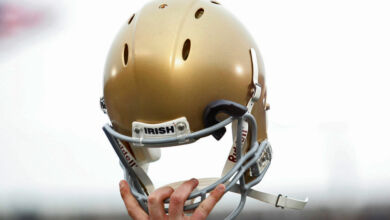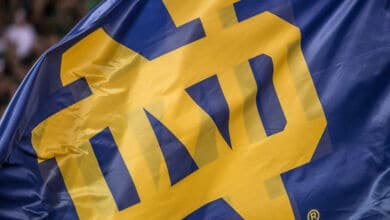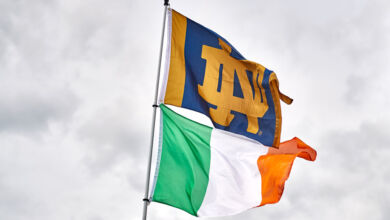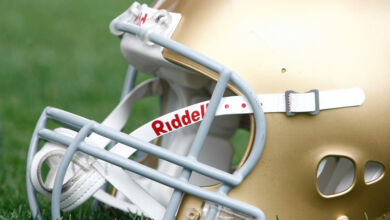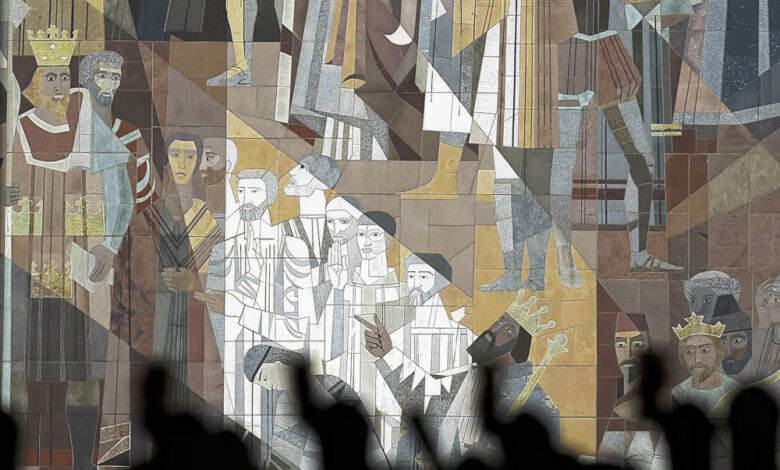
The presence of any walk-on in a college football game usually doesn’t elicit a great deal of notice, much less lay the groundwork for a major motion picture. However, when 27-year-old Dan Ruettiger’s quest to play for Notre Dame was finally achieved on November 8, 1975, it created an indelible memory in the history of Fighting Irish football.
Standing just five-feet-six, Ruettiger, since immortalized as Rudy, took a circuitous route to Notre Dame. That path began with a stint in the Navy, followed by a few years working in a power plant. Due to poor high school grades, he began his college days near Notre Dame at Holy Cross College. By 1974, he began his efforts to join the Irish football team.
Ara Parseghian declined the opportunity to add Ruettiger, but after Parseghian retired following the 1974 campaign, the walk-on was used as cannon fodder on the Irish practice squad the following year. Through the Irish’s first eight games that season, he remained on the sidelines, but in the final minute of the 24-3 Senior Day victory over Georgia Tech, the legend of Rudy began.
The Coaches
Replacing Parseghian was Dan Devine, who had previously been a college head coach at Arizona State and Missouri. More recently, he’d been the head coach of the Green Bay Packers for four years but faced an immense challenge in trying to fill the shoes of his predecessor. In his first eight games as the Notre Dame mentor, his team had won six of eight games.
Pepper Rodgers was in his second season as head coach at Georgia Tech, with the Yellow Jackets also sporting a 6-2 mark. The colorful Rodgers was a stark contrast to Devine’s business-like demeanor, with that image honed during his seven years before Tech at both Kansas and UCLA.
The Key Players
The duo of Rick Slager and Joe Montana handled most of the snaps for the 1975 Irish, though Montana was already establishing himself as a clutch player. However, a finger injury kept him out of this game, so Slager made good use of running backs Al Hunter and Jerome Heavens as well as tight end Ken McAfee. On defense, Notre Dame had held five of their eight opponents to 10 points or less and had budding sophomore superstar Ross Browning up front.
Rodgers’ use of the Wishbone offense helped make Georgia Tech’s running game a headache for opponents, with the Yellow Jackets averaging 356 yards per game in that department. That production was accomplished largely by quarterback Danny Myers and an array of running backs, some missing the contest due to injuries.
The Game
Neutralizing such a high-powered offense was the chief goal of the Notre Dame defense, a task made easier by the ball control achieved by the offense during the game. That unit held the ball for more than 35 minutes against Tech, with the Irish running game collecting 311 yards on the day. Meanwhile, Tech’s attack was held to 143 net yards, less than half of their yearly average.
On the game’s first play from scrimmage, the Yellow Jackets ominously gained 38 yards. However, from that point, Tech’s only other big plays were a pair of broken plays that gained a total of 29 yards Meanwhile, the Notre Dame offense got back on track with 21 first downs after managing just six in each of their previous two games.
The Irish began by advantage of a fumbled pitchout that was recovered by Ross Browner and needed just five plays to notch the first score. That came on a 16-yard scoring run by Heavens. However, a fumble after a subsequent Yellow Jackets punt gave Tech a prime opportunity to tie things up.
Managing just one first down, Tech wouldn’t move the chains again until late in the third quarter. In the meantime, Notre Dame added a field goal to hold a 10-0 advantage at the break. The lead would increase to 17 on the second play of the second half when Heavens broke off a 73-yard scoring run.
The Yellow Jackets managed their only score of the afternoon after an Irish miscue on a punt that was recovered at the Notre Dame 31. A pass interference call got Tech closer before they settled for a 40-yard field goal to make it 17-3 with just under nine minutes remaining.
The Irish appeared to score on their next drive on a 45-yard Jim Browner run, but Notre Dame was flagged for holding. They did end up scoring in the final minute, a three-yard tally by reserve Dan Knott that helped the Rudy legend materialize.
Ruettiger was placed on the kickoff team by assistant George Kelly and watched the ball sail into the end zone for a touchback. Instead of heading off the field, Ruettiger was put on the defensive line. On the first of two plays, he managed to get past the Tech blocking back and narrowly missed a sack.
On the final play of the game, Ruettiger not only got past the back again but brought down Yellow Jackets reserve quarterback Rudy Allen. That iconic moment led two of his Irish teammates, Tom Parise and Ron Cullins, to hoist him on their shoulders and carry him to the Notre Dame locker room.
In the postgame locker room, Ruettiger’s nickname was chanted by his teammates after Devine took time to recognize the moment. Many of those teammates also took time to shake his hand, with assembled media also getting his thoughts of his moment in the sun.
The Aftermath
Notre Dame followed up the Tech win with a 34-20 loss to Pittsburgh, a defeat that knocked them from the national rankings. They managed to defeat the Miami Hurricanes in the regular season finale but despite rumors of a Cotton Bowl bid, the players chose not to play in a bowl game. Two years later, Devine would win the program’s 10th national championship in his third year as head coach at Notre Dame.
Ruettiger’s story faded for more than a decade but was revived in the early 90s, when Angelo Rizzo, the screenwriter for the movie Hoosiers, caught wind of the tale. That led to production commencing in October 1992, with crowd footage from two of Notre Dame games (the Snow Bowl classic against Penn State and a blowout of Boston College) that season used in the film.
The motivational story of Reuttiger made him a highly sought-after speaker to groups, eager to hear a first-hand description of his journey. His tale wasn’t the first movie about Notre Dame football but more than three decades after the film’s release, his 27 seconds of glory remains immortalized for future generations.
